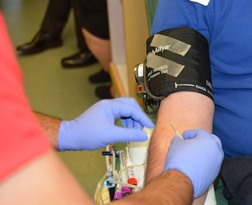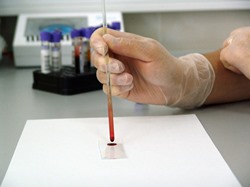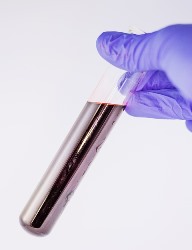Choosing a Phlebotomy Technician School near Scotland South Dakota
 Enrolling in the ideal phlebotomy technician school near Scotland SD is an important initial step toward a fulfilling career as a phlebotomist. It may seem like a challenging undertaking to analyze and compare all of the training alternatives that are available to you. Nevertheless it’s vital that you do your due diligence to ensure that you receive a quality education. In fact, most prospective students start the process by looking at 2 of the qualifiers that first come to mind, which are location and cost. Another factor you might consider is whether to attend online classes or commute to a local campus. We’ll discuss more about online classes later in this article. What you need to keep in mind is that there is far more to checking out phlebotomy training programs than locating the closest or the cheapest one. Other variables including accreditation and reputation are also significant considerations and must be part of your selection process as well. To assist in that effort, we will provide a list of questions that you should ask each of the phlebotomy schools you are assessing to help you select the ideal one for you. But before we do that, let’s cover what a phlebotomist is and does, and afterwards continue our discussion about online schools.
Enrolling in the ideal phlebotomy technician school near Scotland SD is an important initial step toward a fulfilling career as a phlebotomist. It may seem like a challenging undertaking to analyze and compare all of the training alternatives that are available to you. Nevertheless it’s vital that you do your due diligence to ensure that you receive a quality education. In fact, most prospective students start the process by looking at 2 of the qualifiers that first come to mind, which are location and cost. Another factor you might consider is whether to attend online classes or commute to a local campus. We’ll discuss more about online classes later in this article. What you need to keep in mind is that there is far more to checking out phlebotomy training programs than locating the closest or the cheapest one. Other variables including accreditation and reputation are also significant considerations and must be part of your selection process as well. To assist in that effort, we will provide a list of questions that you should ask each of the phlebotomy schools you are assessing to help you select the ideal one for you. But before we do that, let’s cover what a phlebotomist is and does, and afterwards continue our discussion about online schools.
[campusexplorer header_text=”Find Phlebotomy Schools Near You!” aos=”75346615″ concentration=”E7147EE5″ tracking=”PHL-CT”]
Phlebotomy Tech Work Description
 A phlebotomist, or phlebotomy tech, collects blood samples from patients. While that is their main duty, there is actually much more to their job description. Prior to collecting a blood sample, a phlebotomist must verify that the tools being utilized are sterile and single use only. Following the collection, the sample must be correctly labeled with the patient’s information. Next, paperwork must be accurately filled out in order to track the sample from the point of collection through the lab testing process. The phlebotomist then transports the blood to either an an outside lab facility or an in-house lab where it may be tested for such things as pregnancy, infectious diseases or blood type. Some Scotland SD phlebotomists in fact work in labs and are accountable for making certain that samples are tested correctly utilizing the strictest quality control procedures. And if those weren’t enough duties, they may be required to instruct other phlebotomists in the drawing, delivery and follow-up process.
A phlebotomist, or phlebotomy tech, collects blood samples from patients. While that is their main duty, there is actually much more to their job description. Prior to collecting a blood sample, a phlebotomist must verify that the tools being utilized are sterile and single use only. Following the collection, the sample must be correctly labeled with the patient’s information. Next, paperwork must be accurately filled out in order to track the sample from the point of collection through the lab testing process. The phlebotomist then transports the blood to either an an outside lab facility or an in-house lab where it may be tested for such things as pregnancy, infectious diseases or blood type. Some Scotland SD phlebotomists in fact work in labs and are accountable for making certain that samples are tested correctly utilizing the strictest quality control procedures. And if those weren’t enough duties, they may be required to instruct other phlebotomists in the drawing, delivery and follow-up process.
Where are Phlebotomy Techs Employed?
The simplest response is wherever they treat patients. Their work places are many and varied, including Scotland SD medical clinics, hospitals, long-term care facilities, or blood banks. They can be charged to draw blood samples from patients of of every age, from infants or toddlers to senior citizens. A number of phlebotomists, based on their training and their practice, specialize in collecting samples from a particular kind of patient. For example, those practicing in an assisted living facility or nursing home would exclusively be collecting blood from older patients. If they are practicing in a maternity ward, they would be drawing blood from newborns and mothers exclusively. On the other hand, phlebotomy technicians working in a general hospital environment would be drawing blood from a wide range of patients and would work with different patients on a daily basis.
Phlebotomy Technician Education, Certification and Licensing
 There are essentially 2 kinds of programs that provide phlebotomy training in Scotland SD, which are certificate and degree programs. The certificate program usually takes less than a year to complete and furnishes a general education together with the training on how to draw blood. It offers the quickest route to becoming a phlebotomist. An Associate of Science Degree in Clinical Laboratory Science, even though it’s not exclusively a phlebotomist degree, will provide training to become a phlebotomist. Offered at junior and community colleges, they typically take 2 years to complete. Bachelor’s Degrees are not as accessible and as a four year program offer a more extensive foundation in lab sciences. Once you have finished your training, you will probably want to get certified. Although not mandated in most states, many employers require certification before employing technicians. Some of the key certifying agencies include:
There are essentially 2 kinds of programs that provide phlebotomy training in Scotland SD, which are certificate and degree programs. The certificate program usually takes less than a year to complete and furnishes a general education together with the training on how to draw blood. It offers the quickest route to becoming a phlebotomist. An Associate of Science Degree in Clinical Laboratory Science, even though it’s not exclusively a phlebotomist degree, will provide training to become a phlebotomist. Offered at junior and community colleges, they typically take 2 years to complete. Bachelor’s Degrees are not as accessible and as a four year program offer a more extensive foundation in lab sciences. Once you have finished your training, you will probably want to get certified. Although not mandated in most states, many employers require certification before employing technicians. Some of the key certifying agencies include:
- National Phlebotomy Association
- National Healthcareer Association (NHA)
- American Society for Clinical Pathology (ASCP)
- American Medical Technologists (AMT)
There are a few states that do call for certification in order to practice as a phlebotomist, including California and Nevada. California and a handful of other states even require licensing. So it’s imperative that you choose a phlebotomy training program that not only furnishes a superior education, but also preps you for any licensing or certification exams that you elect or are required to take.
Phlebotomist Online Training
 First, let’s resolve one potential misconception. You can’t receive all of your phlebotomy training online. A good component of the course of study will be clinical training and it will be conducted either in an approved Scotland SD healthcare facility or an on-campus lab|an on-campus lab or an approved healthcare facility}. Many courses also require completing an internship in order to graduate. But since the non-practical portion of the training can be attended online, it could be a more convenient option for some students. As an added benefit, many online colleges are more affordable than their traditional counterparts. And some costs, such as those for commuting or textbooks, may be lowered as well. Just make certain that the online phlebotomy program you select is accredited by a national or regional accrediting agency (more on accreditation to follow). With both the comprehensive online and clinical training, you can obtain a superior education with this method of learning. If you are disciplined enough to study at home, then earning your degree or certificate online may be the right choice for you.
First, let’s resolve one potential misconception. You can’t receive all of your phlebotomy training online. A good component of the course of study will be clinical training and it will be conducted either in an approved Scotland SD healthcare facility or an on-campus lab|an on-campus lab or an approved healthcare facility}. Many courses also require completing an internship in order to graduate. But since the non-practical portion of the training can be attended online, it could be a more convenient option for some students. As an added benefit, many online colleges are more affordable than their traditional counterparts. And some costs, such as those for commuting or textbooks, may be lowered as well. Just make certain that the online phlebotomy program you select is accredited by a national or regional accrediting agency (more on accreditation to follow). With both the comprehensive online and clinical training, you can obtain a superior education with this method of learning. If you are disciplined enough to study at home, then earning your degree or certificate online may be the right choice for you.
Points to Ask Phlebotomy Schools
Now that you have a basic understanding about what it takes to become a phlebotomy tech, it’s time to begin your due diligence process. You might have already decided on the kind of program you want to enroll in, whether it be for a certificate or a degree. As we previously mentioned, the location of the South Dakota campus is relevant in addition to the cost of tuition. Perhaps you have decided to enroll in an online phlebotomist program. Each of these decisions are an important part of the process for selecting a school or program. But they are not the sole concerns when arriving at your decision. Below we have provided a few questions that you need to ask about each of the Scotland SD schools you are reviewing before making your final selection.
Is the Phlebotomist Program Specific to Your State? As mentioned previously, each state has its own regulations for practicing as a phlebotomist. Some states require certification, while some others require licensing. Every state has its own prerequisite regarding the minimum hours of practical training performed prior to practicing as a phlebotomist. As a result, you may have to pass a State Board, certification or licensing examination. Therefore it’s very important to choose a phlebotomy program that satisfies the state specific requirements for South Dakota or the state where you will be working and prepares you for any examinations you may have to take.
Is the School Accredited? The phlebotomy school and program you select should be accredited by a reputable national or regional accrediting organization, such as the National Accrediting Agency for Clinical Laboratory Sciences (NAACLS). There are several benefits to graduating from an accredited program in addition to a guarantee of a premium education. To begin with, if your program is not accredited, you will not be able to take a certification examination offered by any of the previously listed certifying organizations. Next, accreditation will help in securing loans or financial assistance, which are frequently not available for non-accredited colleges in Scotland SD. Last, graduating from an accredited college can make you more attractive to potential employers in the job market.
What is the College’s Reputation? In many states there is minimal or no regulation of phlebotomy schools, so there are those that are not of the highest caliber. So in addition to accreditation, it’s important to check the reputations of any colleges you are looking at. You can begin by requesting references from the schools from employers where they refer their students as part of their job assistance program. You can screen internet school rating and review services and solicit the accrediting organizations for their reviews also. You can also talk to several Scotland SD area hospitals or clinics that you may have an interest in working for and find out if they can offer any insights. As a closing thought, you can contact the South Dakota school licensing authority and ask if any grievances have been filed or if the colleges are in full compliance.
Is Enough Training Included? To begin with, check with the South Dakota regulator or the state regulator where you will be working to find out if there are any minimum requirements for the amount of training, both clinical and classroom. At a minimum, any Scotland SD phlebotomist program that you are looking at should provide at least 40 hours of classroom training (most require 120) and 120 hours of practical training. Anything lower than these minimums may indicate that the program is not expansive enough to offer adequate training.
Are Internship Programs Provided? Find out from the South Dakota schools you are considering if they have an internship program in collaboration with regional medical facilities. They are the optimal means to receive hands-on clinical training typically not provided on campus. As an additional benefit, internships can assist students establish contacts within the local Scotland SD medical community. And they are a plus on resumes also.
Is Job Placement Help Available? Landing your first phlebotomy job will be a lot easier with the assistance of a job placement program. Find out if the programs you are reviewing provide assistance and what their job placement percentage is. If a school has a high rate, meaning they place the majority of their students in jobs, it’s an indication that the school has both an excellent reputation together with an extensive network of professional contacts within the Scotland SD healthcare community.
Are Class Times Conveniently Scheduled? And last, it’s critical to confirm that the final school you pick offers classes at times that are compatible with your busy lifestyle. This is particularly true if you decide to continue working while going to school. If you need to go to classes in the evenings or on weekends near Scotland SD, make sure they are available at those times. Additionally, if you can only attend on a part-time basis, make sure it is an option also. Even if you have decided to study online, with the practical training requirement, make sure those hours can also be fulfilled within your schedule. And find out what the make-up policy is should you need to miss any classes because of illness or emergencies.
Why Did You Choose to Become a Phlebotomy Tech?
When preparing to interview for a Phlebotomy Tech job, it's important to consider questions you could be asked. Among the things that hiring managers often ask Phlebotomy Tech applicants is "What compelled you to choose Phlebotomy as a career?". What the interviewer is hoping to uncover is not only the private reasons you may have for being Phlebotomy Tech, but also what qualities and abilities you possess that make you good at your profession. You will probably be asked questions relating primarily to Phlebotomy, along with a significant number of standard interview questions, so you should prepare some approaches about how you would like to address them. Since there are so many variables that go into choosing a career, you can answer this primary question in a variety of ways. When preparing an answer, aim to include the reasons the work interests you along with the talents you have that make you an excellent Phlebotomist and the perfiect candidate for the job. Don't try to memorize an answer, but write down several ideas and anecdotes that relate to your personal strengths and experiences. Going over sample answers can help you to formulate your own thoughts, and inspire ideas of what to include to enthuse the interviewer.Find the Right Phlebotomy Course near Scotland SD
Making sure that you choose the right phlebotomist training is an essential first step toward your success in this rewarding medical care field. As we have covered in this article, there are a number of factors that contribute toward the selection of a premium college. Phlebotomist training programs are offered in a wide range of educational institutions, including junior or community colleges, trade schools, and colleges and universities that offer an extensive array of courses in medical care and health sciences. Training program offerings can differ somewhat from state to state as every state has its own mandates when it concerns phlebotomy training, certification and licensing. The most important point is that you need to thoroughly research and compare each program before making your ultimate choice. By asking the questions that we have provided, you will be able to narrow down your options so that you can pick the best college for you. And with the appropriate training, you can achieve your goal of becoming a phlebotomy technician in Scotland SD.
Learn About Scotland South Dakota
£sd
£sd (pronounced /ɛlɛsˈdiː/ ell-ess-dee and occasionally written Lsd) is the popular name for the pre-decimal currencies once common throughout Europe, especially in the British Isles and hence in several countries of the British Empire and subsequently the Commonwealth. The abbreviation originates from the Latin currency denominations librae, solidi, and denarii.[1] In the United Kingdom, which was one of the last to abandon the system, these were referred to as pounds, shillings, and pence (pence being the plural of penny).
This system originated in the classical Roman Empire. It was re-introduced into Western Europe by Charlemagne, and was the standard for many centuries across the continent. In Britain it was King Offa of Mercia who adopted the Frankish silver standard of librae, solidi and denarii in the late 8th century,[2] and the system was used in much of the British Commonwealth until the 1960s and 1970s, with Nigeria being the last to abandon it with the introduction of the naira on 1 January 1973.
Under this system, there were 12 pence in a shilling and 20 shillings, or 240 pence, in a pound. The penny was subdivided into 4 farthings until 31 December 1960, when they ceased to be legal tender in the UK, and until 31 July 1969 there were also halfpennies ("ha'pennies") in circulation. The advantage of such a system was its use in mental arithmetic, as it afforded many factors and hence fractions of a pound such as tenths, eighths, sixths and even sevenths and ninths if the guinea (worth 21 shillings) was used. When dealing with items in dozens, multiplication and division are straightforward; for example, if a dozen eggs cost four shillings, then each egg was priced at fourpence.
As countries of the British Empire became independent, some (like the United States) abandoned the £sd system quickly, while others retained it almost as long as the UK itself. Australia for example, only changed to using a decimal currency on 14 February 1966. Still others, notably Ireland, decimalised only when the UK did. The UK abandoned the old penny on Decimal Day, 15 February 1971, when one pound sterling became divided into 100 new pence. This was a change from the system used in the earlier wave of decimalisations, in Australia, New Zealand, Rhodesia and South Africa, in which the pound was divided into two of a new major currency called the "dollar" or "rand." The British shilling was replaced by a 5 new pence coin worth one-twentieth of a pound.
More Interesting South Dakota Cities
Scotland SD Blood Labs - BingNews Search results
-
Five of Scotland's stereotypes: fact or fantasy?
For all the great artists, philosophers and scientists that Scotland has produced over the centuries of its proud history, most stereotypes about Scots tend to involve kilts, ruddy complexions and ...
-
The Best Lab-Grown Diamonds, According To A Gem Expert
Even the best lab-grown diamonds can stir up a bit of skepticism in shoppers—and for good reason. You might wonder: How can anything concocted in a laboratory compare to what’s organically ...
-
Scotland 0-0 Portugal: Steve Clarke's side hang on for first Nations League point
Cristiano Ronaldo failed to shine as Scotland avoided another late Portugal defeat to earn their first point from a 0-0 draw in the Nations League. Steve Clarke's side went into the match without ...
-
Scotland vs Portugal: Steve Clarke believes positive result in Nations League game would 'change whole mood'
Steve Clarke believes Scotland can "change the mood about the place" with a positive result against Portugal in the Nations League on Tuesday. The Scots are winless in their last nine competitive ...
-
Alex Salmond, former first minister of Scotland, dies aged 69
Alex Salmond, the former first minister of Scotland who led the 2014 independence referendum, has died at the age of 69. The ex-Scottish National Party leader collapsed and died on Saturday ...
-
Former first minister of Scotland Alex Salmond dies
Former first minister of Scotland Alex Salmond has died aged 69. Mr Salmond, who led the Scottish National Party between 1990 and 2000 and then again between 2004 and 2014, was a prominent figure ...
-
There's never been a better time to discover this beautiful region, which is right on the doorstep
But the south of Scotland is a hidden gem that’s easy to reach. It’s also an ideal place to spend a relaxing autumn and winter break without the hassle of lengthy queues at airports or ferry ...
-
Scotland, SD Current Weather
Solar max has arrived! Here’s how and where to see the Northern Lights 1:05 Orionid meteor shower: When to see debris from Halley's Comet in the night sky Some lady beetles bite. Here's how to ...
-
Medical Genomics Lab
Please reach out to our lab at least one week prior to a scheduled biopsy procedure to request the media kit to ensure sufficient time for the kit to arrive before the scheduled date. To request the ...
-
Inside Scotland's wetsuit testing lab: shivering in the name of science
The Lost Shore artificial wave park at Ratho was the trigger for a collaboration between surfers and scientists at Edinburgh Napier University, writes Roger Cox This September, Scotland’s ...
-
Scotland to ditch key climate change target
The final goal of reaching "net-zero" by 2045 will remain, but BBC Scotland News understands the government's annual climate targets could also go. Ministers have missed eight of the last 12 ...
